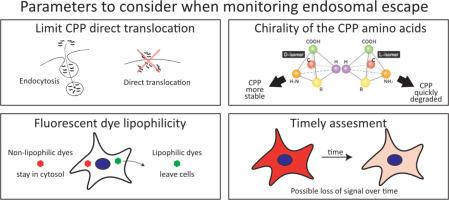荧光细胞穿透肽的内体逃逸监测。
IF 4.7
3区 医学
Q1 PHARMACOLOGY & PHARMACY
引用次数: 0
摘要
细胞穿透肽(CPPs)具有通过内吞作用或直接跨质膜转运货物进入细胞的能力。通过内吞作用进入的CPPs通常被困在核内体和溶酶体中。可以通过将CPPs偶联到促进内体逃逸的货物或使用渗透内体或溶酶体的小分子来减轻这种夹带。l-亮氨酸甲酯(LLOMe)就是这种分子的一个例子。CPP内体逃逸到胞质溶胶的评估不是微不足道的,因为胞质获得也可以通过CPP跨质膜的直接易位发生。此外,可视化CPP胞质获取通常需要用荧光团标记CPP,荧光团可以影响CPP的行为,也可以在核内体和溶酶体的降解环境中从CPP中释放出来。在目前的工作中,我们探索了可能影响CPP逃逸记录的各种参数,例如制造CPPs的氨基酸的手性,与CPPs耦合的荧光团的性质以及记录的时间。为此,我们使用了三种常用的CPP: R9(一种由9种精氨酸组成的合成CPP)、TAT和穿透素。我们使用LLOMe作为内体逃逸启动子。本研究提出了评估CPP内体逃逸的指导方针。我们还提供了一个框架,用于选择氨基酸手性、荧光团类型和评估时间的适当组合,这些组合基于研究人员希望在cpp货物从囊泡释放到细胞质中时实现的目标。本文章由计算机程序翻译,如有差异,请以英文原文为准。

Monitoring endosomal escape of fluorescent cell-penetrating peptides
Cell-penetrating peptides (CPPs) have the capacity to transport cargos into cells either through endocytosis or direct translocation across the plasma membrane. CPPs entering via endocytosis remain generally trapped within endosomes and lysosomes. This entrapment can be alleviated by coupling the CPPs to endosomal escape promoting cargos or by using small molecules that permeate endosomes or lysosomes. L-Leucyl-L-Leucine methyl ester (LLOMe) is an example of such a molecule.
The assessment of CPP endosomal escape into the cytosol is not trivial as cytosolic acquisition can also occur via CPP direct translocation across the plasma membrane. Moreover, visualization of CPP cytosolic acquisition often requires the CPP to be tagged with a fluorophore that can affect the behavior of the CPP and that can also be released from the CPP in the degradative environment of endosomes and lysosomes. In the present work, we have explored various parameters that can potentially affect the recording of CPP endosomal escape, such as the chirality of the amino acids making the CPPs, the nature of the fluorophore coupled to the CPPs, and the timing of the recording. For this purpose, we have used three commonly used CPPs: R9 (a synthetic CPP made of 9 arginines), TAT, and penetratin. We have used LLOMe as the endosomal escape promoter.
This study presents guidelines for the assessment of CPP endosomal escape. We also provide a framework for selecting appropriate combinations of amino acid chirality, fluorophore type, and assessment timing based on what researchers want to achieve when the CPP-cargo is released from vesicles into the cytosol.
求助全文
通过发布文献求助,成功后即可免费获取论文全文。
去求助
来源期刊
CiteScore
9.60
自引率
2.20%
发文量
248
审稿时长
50 days
期刊介绍:
The journal publishes research articles, review articles and scientific commentaries on all aspects of the pharmaceutical sciences with emphasis on conceptual novelty and scientific quality. The Editors welcome articles in this multidisciplinary field, with a focus on topics relevant for drug discovery and development.
More specifically, the Journal publishes reports on medicinal chemistry, pharmacology, drug absorption and metabolism, pharmacokinetics and pharmacodynamics, pharmaceutical and biomedical analysis, drug delivery (including gene delivery), drug targeting, pharmaceutical technology, pharmaceutical biotechnology and clinical drug evaluation. The journal will typically not give priority to manuscripts focusing primarily on organic synthesis, natural products, adaptation of analytical approaches, or discussions pertaining to drug policy making.
Scientific commentaries and review articles are generally by invitation only or by consent of the Editors. Proceedings of scientific meetings may be published as special issues or supplements to the Journal.

 求助内容:
求助内容: 应助结果提醒方式:
应助结果提醒方式:


